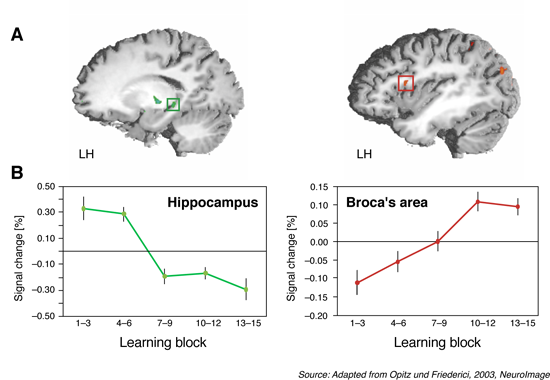Artificial grammar learning
Broca’s area as the core region for syntactic computations has not only been manifested in studies in different language such as English, German, Dutch, Japanese and Hebrew but also in studies using artificial grammars.
A key study demonstrated that humans are able to learn and process a novel language when it follows the principles of natural grammars, but not when the language disobeying these principles (Musso et al., 2003). Processing the language obeying the principles of natural grammars activated Broca’s area (BA 45).
Other studies reported the involvement of Broca’s area for the processing of hierarchical dependencies in artificial grammars (Bahlmann et al., 2008; Friederici et al., 2006a), and by using transcranial direct current stimulation that Broca’s area is causal involved in artificial grammar learning and processing (de Vries et al., 2010; Uddén et al., 2008).
Another fMRI study focused on the learning process as such and its underlying brain activation patterns in a 40 minutes learning session (Opitz & Friederici, 2003). It was found that initially the left hippocampus is maximally activated whereas Broca’s area is not. Over the course of learning the activation in Broca’s area systematically increases, whereas the activation in the hippocampus decreases.
In sum, these studies on grammar learning and processing indicate that Broca’s area plays a crucial role in the processing of syntax.

Figure 10: Brain activation during artificial grammar learning
A: Location of brain activation in the Hippocampus and Broca’s area. B: Signal change in the two brain regions plotted as a function of learning overtime (from learning 1 to 15). Activation in the Hippocampus decreases and activation in Broca’s area increases during grammar learning. Figure legend is taken from Friederici, 2011 (Physiological Reviews, 91(4), 1357-1392).